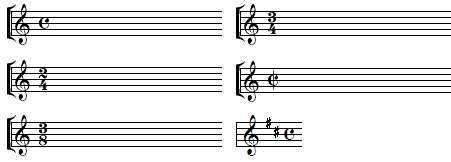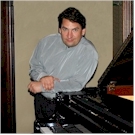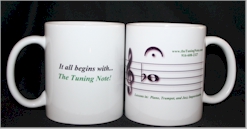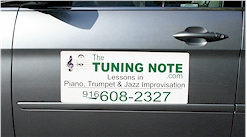| Measure: | This is the area on a staff between two bar lines (measure lines). The number of beats in each measure must all be the same, and must equal the top number of the time signature.
 |
| Bar line/Measure line: | This is a vertical line drawn on a staff from its highest line down to its lowest line and used to separate bars/measures, each having the same number of beats as indicated by the time signature.
 |
| Repeat sign: | There are different repeat signs used in music, but the most common is the one found where a measure line would be. This repeat sign is shown as two vertical lines, one thick and one thin, with two dots shown above and below the middle line of the staff. The musician needs to return to the previous repeat sign and play those measures again, basically playing the music found between the two dots on each repeat sign.
 |
| Note Part - Stem: | This is the vertical line that extends from a note head. Depending on where a note is placed on a staff, a stem will go up from the right side of the note head, or down from the left side. The stem is also important as it can be used to indicate "voicing", either within a piano piece, or to indicate which notes different singers might sing when using the same staff.
 |
| Time Signature: | Generally found at the beginning of a piece of music on the first staff, this is most often shown as two numbers, one on top of the other, found at the leftmost side of the staff, just after the clef and key signature. These two numbers together are called the Time Signature, and determines how many beats per measure there should be (the upper number), and which note type should get each beat (the lower number). Regarding the lower number, a 4 represents a quarter note, while a 2 represents a half note, a 1 represents a whole note and an 8 represents an eighth note. Additionally, if a "C" is shown, this represents "Common Time" and is the same as 4/4. If a C with a vertical slash through it is shown, this represents "Cut Time" and is the same as 2/2.
 |
| Common Time: | This refers to the time signature, and instead of numbers a letter C is shown. This means the same as 4/4.
 |
| Note Type - Quarter note: | This type of note is shown as a solid note head (filled in) and has a stem. The duration of this note type is typically 1 beat. Quarter notes are never connected by their stems.
 |
| Note Type - Half note: | This type of note is shown as a empty note head (not filled in) and has a stem. The duration of this note type is typically 2 beats. Half notes are never connected by their stems.
 |
| Note Type - Whole note: | This type of note is shown as only an empty note head (not filled in) and does not have a stem. The duration of this note type is typically 4 beats.
 |
| Note Type - Eighth note: | This type of note is shown as a solid note head (filled in) and has a stem. The duration of this note type is typically 1/2 of a beat. For a stand alone eighth note the stem has a 'flag' line coming from the end of the stem; for connected eighth notes, the ends of the stems are joined.
 |
| Dotted Note: | When a note head has a dot just after it, this means to add 1/2 of its duration (how many beats it gets), to how many beats it already gets. For example, a whole note gets 4 beats, but a dotted whole note gets 6 beats; a half note gets 2 beats, but a dotted half note gets 3 beats; a quarter note gets 1 beat, but a dotted quarter note gets 1 1/2 beats. |
| Rest Type - Quarter rest: | This is a type of rest, where the musician rests, or doesn't play. The duration of this rest type is typically 1 beat.
 |
| Rest Type - Half rest: | This is a type of rest, where the musician rests, or doesn't play. The duration of this rest type is typically 2 beats.
 |
| Rest Type - Whole rest: | This is a type of rest, where the musician rests, or doesn't play. The duration of this rest type is typically 4 beats.
 |
| Rest Type - Eighth rest: | This is a type of rest, where the musician rests, or doesn't play. The duration of this rest type is typically 1/2 of a beat.
 |
| Tie: | This symbol is a curved line, similar to a slur, yet is connecting two of the exact same notes over a measure line. When a note is 'tied' from the previous measure, you do not re-play the note but continuing holding it from the previous measure.
 |
| Subdivision: | This refers to the idea of dividing a beat into smaller parts. You can think of it as dividing it into 2 parts (in 4/4: eighth notes), 3 parts (in 4/4: 8th note triplets), 4 parts (in 4/4: 16th notes) and so on. |
| Metronome: | A tool for musicians that measures beats per minute. If you set a metronome to "60", the beats would sound one every second. |
| Downbeat: | This basically refers to each beat, but can best be illustrated by watching someone conduct. When they move there arms and stop after going downward, the bottom of their stroke is called the downbeat. When counting in music, each number in "1 - 2 - 3 - 4" is a downbeat. |
| Upbeat: | This generally refers to the 'middle of a beat'. For example, if you were to count "1 - 2 - 1 - 2", then count again with the same beats but add "and" in between the beats, such as "1 - and - 2 - and - 1 - and - 2", the "ands" would be on the upbeats, where the 1's and 2's would be on the downbeats. |
| Pick Up Note: | This generally refers to a note that is part of a phrase, yet appears at the end of a measure with the remaining part of the phrase continuing into the next measure(s). Sometimes this can be found at the beginning of a piece of music where, what would be the very first measure, the note(s) are within a "partial measure" where the composer or editor chose not to reflect the full number of beats required. |
| Interval - Unison: | This is what the "distance" is called when two exact notes are played at the same time. It might be easier to think of two singers singing the exact same note; in this instance they are said to be "singing in unison." |
| Interval - Octave: | This is the distance between one note and another, where the upper note is the very next note of the same name. This distance also equals 6 whole steps. |
| Slur: | This is a phrase marking, which generally means to 'connect' all the notes found within the slur marking, so they go smoothly from one to the other.
 |
| Tempo Marking (in the music) - Ritardando / Ritard. / Rit.: | This means to gradually slow down in tempo. |
| Accent: | This means to give more emphasis to the note or notes and is represented by a "greater than sign":
 |
| Staccato: | this means "short" and is represented by a dot above the note. For pianists, most often these should be played with a little bounce in the wrist. |
| Staff: | This term refers to the five horizontal lines and four spaces, and is the fundamental way for music to be notated. There are several different clefs that determine what lines and spaces represent which note names.
 |
| Ledger line: | This is an extra line that is written to extend a staff, either higher or lower. It is necessary to write ledger lines so notes can be played beyond what the staff provides.
 |
| Clef - Treble Clef: | This symbol is placed on the leftmost side of a staff, and for pianists is usually found on the top staff of a grand staff. As Middle C is the first ledger line below this staff, the majority of notes in relation to this staff are above Middle C and therefore are almost always played by the right hand. This clef is also known as the G Clef as the beginning of its shape surrounds the 2nd line of the treble clef staff, the G line.
 |
| Clef - Bass Clef: | This symbol is placed on the leftmost side of a staff, and for pianists is usually found on the bottom staff of a grand staff. As Middle C is the first ledger line above this staff, the majority of notes in relation to this staff are below Middle C and therefore are almost always played by the left hand. This clef is also known as the F Clef as the beginning of this symbol, and its two dots, are based on the 4th line of the bass cleff staff, the F line.
 |
| Note Names: | The letters of the music alphabet consist of letters A through G only. Each staff of a typical Grand Staff (i.e., a Treble Clef Staff over a Bass Clef Staff) has their own note names set for each line and space. Each staff is shown below with their corresponding note names:
 |
| Dynamics: | This is a term that refers to the soft and loud spots of music. If a piece of music has only one dynamic level, then it is only soft, or only loud, etc. If your teacher says, "this week practice the dynamics" that means to change your volume whenever the music is marked to play soft or to play loud. |
| Dynamic Marking - forte: | This means to play "loud." |
| Dynamic Marking - mezzo forte: | This means to play "medium loud." |
| Dynamic Marking - mezzo piano: | This means to play "medium soft." |
| Dynamic Marking - piano: | This means to play "soft." |
| Dynamic Marking - pianissimo: | This means to play "very soft." |
| Crescendo: | This symbol is used to indicate the music should gradually get louder.
 |
| Decrescendo: | This symbol is used to indicate the music should gradually get softer.
 |
| Fermata: | this means to simply "hold" the note or chord. You decide after a reasonable amount of time to release the note(s).
 |
| 1/2 Step: | On the piano this is the distance between two keys that are right next to each other, regardless of color. So that means the distance from a B to the C right next to it is a 1/2 step! |
| Whole Step: | On the piano this is the distance between two keys, regardless of color, that have only one key in between. Therefore, the distance from a C to a D is a whole step; and so is the distance from a B to a C#. |
| Sharp sign: | This is a symbol that tells the musician to raise the note by a 1/2 step. Important: when just writing a sharped note name, the sharp sign goes after the note, but when writing the note on a staff, the sharp sign goes before the note.
 |
| Flat sign: | This is a symbol that tells the musician to lower the note by a 1/2 step. Important: when just writing a flatted note name, the flat sign goes after the note, but when writing the note on a staff, the flat sign goes before the note.
 |
| Natural sign: | This is a symbol that tells a musician to "make natural", or "un-flat" or "un-sharp" a note that should otherwise be flat or sharp. A note should be automatically flat or sharp if a) there is a flat or sharp sign for it in the key signature, or b) if in the same measure there is already a note before it of the same name, that is made flat or made sharp.
 |
| Accidental: | This refers to any sign (flat, sharp, or natural sign) used for a note that is not already represented in the key signature. |
| Key Signature: | The area at the beginning of the staff, just after the clef, which determines the overall key a piece of music is in. The number of sharps or flats shown relates to its Major or Natural Minor scale.

|











